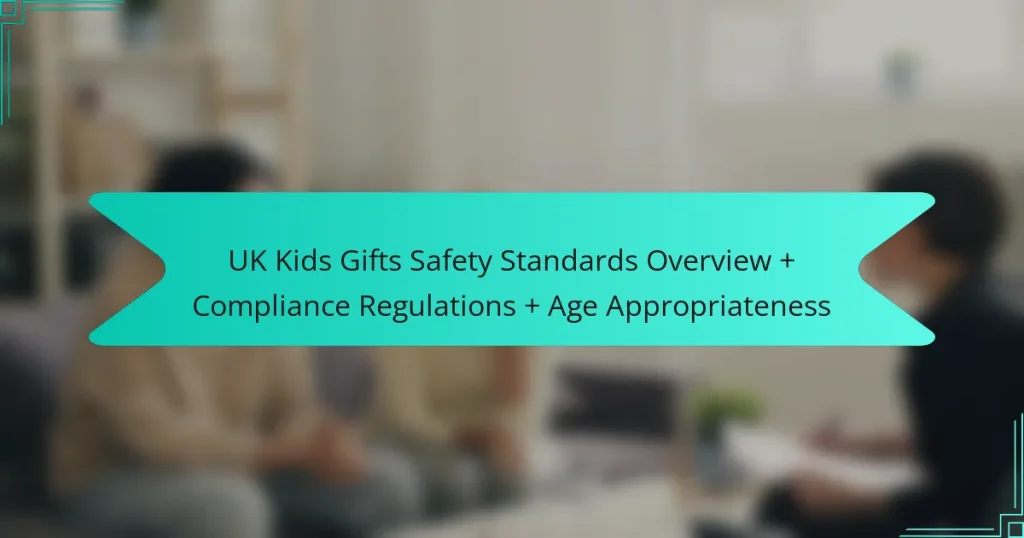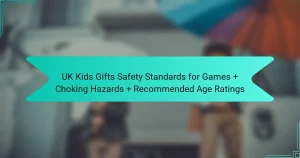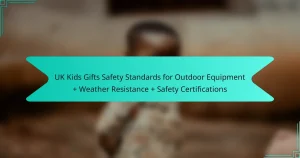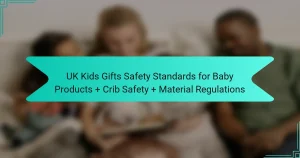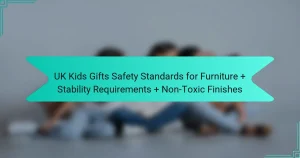The UK Kids Gifts Safety Standards are regulations that ensure toys and gifts for children are safe for use. Key components include the EN71 safety standard, which addresses mechanical and physical properties, flammability, and chemical safety, with compliance being mandatory for all toys sold in the UK. The Toys (Safety) Regulations 2011 govern these standards, requiring manufacturers to ensure toys are free from harmful substances and choking hazards, undergo appropriate testing, and feature clear labeling with age warnings. Regulatory bodies, such as the Office for Product Safety and Standards, monitor compliance to protect children’s health and safety, while age appropriateness is determined by developmental guidelines to promote safe play and learning.

What are the UK Kids Gifts Safety Standards?
The UK Kids Gifts Safety Standards are regulations ensuring that toys and gifts for children are safe for use. These standards include the EN71 safety standard, which covers mechanical and physical properties, flammability, and chemical safety. Compliance with these standards is mandatory for all toys sold in the UK. The regulations aim to minimize risks of injury or harm to children. The UK government enforces these standards through inspections and market surveillance. Non-compliance can result in product recalls and legal penalties. These standards are designed to protect children’s health and safety while encouraging safe play.
How are these safety standards developed and enforced?
Safety standards for kids’ gifts in the UK are developed through a combination of government regulations, industry standards, and stakeholder input. The British Standards Institution (BSI) plays a crucial role in creating these standards. They collaborate with experts to assess safety risks associated with children’s products. The standards are then published and made available for manufacturers and retailers.
Enforcement of these safety standards is conducted by various regulatory bodies, including Trading Standards and the Office for Product Safety and Standards (OPSS). These organizations monitor compliance through inspections and testing of products in the market. Non-compliance can lead to product recalls, fines, or legal action against manufacturers. The UK government also emphasizes consumer safety through public awareness campaigns and guidance for businesses on compliance.
What organizations are responsible for UK kids gifts safety standards?
The organizations responsible for UK kids gifts safety standards include the British Standards Institution (BSI) and the Office for Product Safety and Standards (OPSS). The BSI develops safety standards for various products, including toys and children’s gifts. The OPSS oversees product safety regulations and compliance in the UK. These organizations ensure that gifts for children meet safety criteria to protect young users. Compliance with these standards is crucial for manufacturers and retailers in the UK market.
What processes are involved in the formulation of these standards?
The processes involved in the formulation of UK Kids Gifts Safety Standards include research, stakeholder consultation, drafting, review, and approval. Research involves gathering data on safety risks associated with children’s gifts. Stakeholder consultation engages manufacturers, retailers, and safety experts to gather insights. Drafting creates the initial version of the standards based on the collected data. Review processes involve assessing the draft for feasibility and effectiveness. Approval requires endorsement from regulatory bodies to ensure compliance with legal requirements. Each step is crucial to ensure that the standards effectively protect children from potential hazards.
What are the key components of UK kids gifts safety standards?
The key components of UK kids gifts safety standards include compliance with the General Product Safety Regulations 2005. These regulations require that all toys and children’s products are safe for use. Products must undergo safety assessments to ensure they do not pose choking hazards or contain harmful substances. Additionally, labeling requirements mandate clear age recommendations. Manufacturers must provide instructions and safety warnings. Regular testing by accredited laboratories is essential to maintain compliance. The standards also emphasize the importance of durable materials that can withstand wear and tear. Compliance with these standards is enforced by Trading Standards authorities across the UK.
What types of hazards do these standards address?
The UK Kids Gifts Safety Standards address several types of hazards. These include choking hazards from small parts, sharp edges, and toxic materials. They also cover hazards related to flammability and electrical components. The standards ensure that gifts are safe for children of various ages. Compliance with these standards is crucial for manufacturers. Violations can lead to product recalls and legal consequences. The emphasis on safety aims to protect children’s health and well-being.
How do materials used in kids’ gifts impact safety compliance?
Materials used in kids’ gifts significantly impact safety compliance. The choice of materials determines whether products meet safety standards set by regulatory bodies. For example, non-toxic and durable materials are essential to prevent hazards such as choking or chemical exposure. Compliance regulations in the UK, like EN71, mandate specific material safety tests. These tests assess risks associated with substances like lead or phthalates. Failure to use compliant materials can lead to product recalls and legal consequences. Thus, manufacturers must prioritize safe materials to ensure compliance with safety standards.

What are the compliance regulations for kids’ gifts in the UK?
The compliance regulations for kids’ gifts in the UK are primarily governed by the Toys (Safety) Regulations 2011. These regulations enforce safety standards to ensure that toys are safe for children. Manufacturers must ensure that toys meet essential safety requirements. This includes being free from harmful substances and not posing choking hazards.
Additionally, toys must undergo appropriate testing before they are sold. The regulations require clear labeling, including age warnings and safety instructions. Compliance is monitored by the Office for Product Safety and Standards. Non-compliance can lead to penalties or product recalls. These measures are in place to protect children’s health and safety.
What is the importance of compliance for manufacturers and retailers?
Compliance is crucial for manufacturers and retailers to ensure product safety and legal adherence. It protects consumers from hazardous products, which can lead to injuries or health issues. Compliance with safety standards helps avoid legal penalties and potential lawsuits. For example, non-compliance can result in fines up to £20,000 in the UK. Additionally, adherence to regulations enhances brand reputation and consumer trust. Companies that comply are more likely to attract customers who prioritize safety. Overall, compliance safeguards both businesses and consumers, fostering a safer marketplace.
What are the consequences of non-compliance with safety regulations?
Non-compliance with safety regulations can lead to severe consequences. These consequences include legal penalties, such as fines or sanctions. Companies may face lawsuits from consumers injured by unsafe products. Non-compliance can also result in product recalls, which can damage a brand’s reputation. Additionally, businesses may experience increased scrutiny from regulatory bodies. This scrutiny can lead to more frequent inspections and audits. Ultimately, non-compliance jeopardizes consumer trust and safety. Evidence shows that over 70% of recalls are due to safety violations, underscoring the importance of adherence to regulations.
How can businesses ensure compliance with UK kids gifts safety standards?
Businesses can ensure compliance with UK kids gifts safety standards by adhering to the relevant regulations and testing requirements. They must follow the General Product Safety Regulations 2005, which mandates that products must be safe for use by children. Conducting thorough risk assessments is essential to identify potential hazards associated with the gifts. Additionally, businesses should ensure that products meet the specific safety standards outlined in the EN71 series, which covers toy safety.
Regular testing by accredited laboratories can verify that products comply with these safety standards. Documentation of compliance, including certificates and test reports, should be maintained for auditing purposes. Staff training on safety regulations and best practices can further enhance compliance efforts. By implementing these measures, businesses can effectively align with UK safety standards for children’s gifts.
What documentation is required for compliance?
The documentation required for compliance with UK Kids Gifts Safety Standards includes a Declaration of Conformity. This document confirms that the product meets all relevant safety regulations. Manufacturers must also maintain technical files that detail product specifications and safety assessments. Risk assessments are crucial to identify potential hazards associated with the product. Test reports from accredited laboratories are necessary to prove compliance with safety standards. Labels and warnings on products must be clear and age-appropriate. Records of supply chain and traceability documentation are also essential for compliance verification. These documents collectively ensure that products are safe for children and adhere to legal requirements.
What types of certificates and testing reports are necessary?
Necessary certificates and testing reports include the EN71 toy safety standard certificate. This certificate ensures that toys meet safety requirements for children. Testing reports for chemical content are also required. These reports confirm compliance with regulations regarding harmful substances. Additionally, CE marking is essential for products sold in the UK. This marking indicates that the product meets EU safety standards. For certain items, a declaration of conformity may be necessary. This document states that the product complies with relevant safety regulations. Compliance with these requirements is crucial for market access and consumer safety.
How often should compliance documentation be updated?
Compliance documentation should be updated at least annually. This ensures that it reflects current regulations and standards. Regular reviews are essential to maintain compliance with safety requirements. Changes in laws or industry standards may necessitate more frequent updates. For example, new safety guidelines can emerge that require immediate documentation adjustments. Additionally, if there are changes in product design or materials, documentation must be revised accordingly. Keeping compliance documentation current minimizes legal risks and enhances consumer trust.

How is age appropriateness determined for kids’ gifts?
Age appropriateness for kids’ gifts is determined by safety standards and developmental guidelines. These criteria assess factors like physical size, choking hazards, and cognitive skills. Regulatory bodies, such as the British Standards Institution, set specific age recommendations. Toys must pass testing for safety to ensure they are suitable for the intended age group. For example, a toy labeled for ages 3 and up must not contain small parts that pose choking risks for younger children. Manufacturers often include age labels based on these assessments. Research indicates that toys designed for specific age ranges promote safe play and learning. Compliance with these standards helps prevent accidents and injuries among children.
What factors influence age appropriateness in gift selection?
Age appropriateness in gift selection is influenced by developmental stages, safety standards, and interests. Developmental stages determine cognitive and physical abilities. For example, toys for younger children must be simple and safe. Safety standards, such as those outlined in UK regulations, ensure products are suitable for specific age groups. These standards include guidelines on choking hazards and material safety. Interests also play a crucial role; gifts should align with a child’s hobbies and preferences. Research indicates that age-appropriate gifts enhance learning and play experiences. Therefore, considering these factors is essential for selecting suitable gifts.
How do developmental stages affect age recommendations?
Developmental stages significantly influence age recommendations for children’s products. Each stage represents distinct physical, cognitive, and emotional capabilities. For instance, infants require toys that promote sensory exploration, while toddlers benefit from items that encourage fine motor skills. Age recommendations are established based on safety assessments and developmental appropriateness. Research indicates that toys designed for specific age groups reduce the risk of hazards. The UK safety standards mandate compliance with these recommendations to ensure child safety and well-being. Thus, understanding developmental stages is crucial for making informed age recommendations in product design and marketing.
What role do safety standards play in determining age appropriateness?
Safety standards play a crucial role in determining age appropriateness for children’s products. These standards ensure that items are safe for specific age groups. They are established based on research into children’s developmental stages and potential hazards. Compliance with safety standards helps manufacturers design products that minimize risks. For instance, toys for younger children must not contain small parts that pose choking hazards. The British Standard BS EN 71 outlines safety requirements for toys, influencing age labeling. This regulation helps consumers make informed decisions regarding suitable products for their children. Thus, safety standards directly impact the classification of products by age appropriateness.
What are the common misconceptions about age appropriateness?
Common misconceptions about age appropriateness include the belief that all toys labeled for a specific age are safe for every child in that age group. This is incorrect because individual development varies significantly among children. Another misconception is that age recommendations are solely based on safety. In reality, they also consider developmental skills and interests. Some people think that if a toy is marketed to a certain age, it is appropriate for all children within that age range. However, this overlooks the unique needs and maturity levels of individual children. Additionally, there is a misconception that parents can always determine what is appropriate for their child. Research indicates that many parents underestimate the importance of age ratings, leading to potentially unsafe choices. Understanding these misconceptions is crucial for ensuring that children receive gifts that are both safe and suitable for their developmental stage.
How can parents and caregivers make informed choices regarding age-appropriate gifts?
Parents and caregivers can make informed choices regarding age-appropriate gifts by understanding safety standards and age recommendations. They should consult guidelines from organizations like the British Standards Institution (BSI). These guidelines provide insight into the safety and suitability of toys for different age groups. Additionally, product labels often indicate age recommendations based on developmental stages. Parents should also consider the child’s interests and abilities. Research shows that age-appropriate gifts enhance learning and development. By prioritizing safety and developmental needs, caregivers can select gifts that are both enjoyable and beneficial.
What resources are available for understanding age appropriateness in kids’ gifts?
Resources for understanding age appropriateness in kids’ gifts include guidelines from the British Toy and Hobby Association (BTHA). The BTHA provides a comprehensive age grading system for toys. This system categorizes toys based on the developmental stages of children. The UK government also offers safety standards through the Toy Safety Directive. This directive outlines safety requirements and age recommendations for toys sold in the UK. Additionally, the European Committee for Standardization (CEN) publishes standards for toy safety, which include age appropriateness. Consumer organizations like Which? provide reviews and recommendations for age-appropriate toys. These resources help ensure that gifts are suitable for children’s ages and developmental levels.
What best practices should be followed for ensuring safety and compliance in kids’ gifts?
To ensure safety and compliance in kids’ gifts, manufacturers must adhere to established safety standards. Compliance with the UK Toy Safety Regulations 2011 is essential. This includes testing for hazardous substances and sharp edges. Age appropriateness must be clearly labeled on packaging. Gifts should not contain small parts for children under three years. Regular safety audits and risk assessments are necessary to identify potential hazards. Additionally, maintaining proper documentation of safety tests is crucial. Following these practices minimizes the risk of injury and ensures legal compliance.
UK Kids Gifts Safety Standards are regulations designed to ensure the safety of toys and gifts for children in the UK, including compliance with the EN71 safety standard. The article covers the development and enforcement of these standards by organizations like the British Standards Institution (BSI) and the Office for Product Safety and Standards (OPSS), highlighting the importance of compliance for manufacturers and retailers. Key components include safety assessments, labeling requirements, and the impact of materials used in products. Additionally, the article addresses age appropriateness in gift selection, common misconceptions, and best practices for ensuring safety and compliance.
